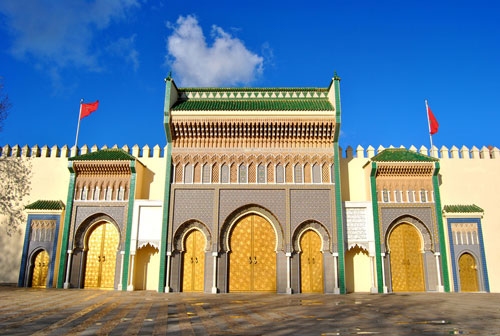Fez is a city in northern inland Morocco and the capital of the Fès-Meknès administrative region. It is the second largest city of Morocco after Casablanca, with a population of 1.1 million (2014). Located to the northeast of Atlas Mountains, Fez is situated at the crossroad of the important cities of all regions; 206 km (128 mi) from Tangier to the northwest, 246 km (153 mi) from Casablanca, 169 km (105 mi) from Rabat to the west, and 387 km (240 mi) from Marrakesh to the southwest which leads to the Trans-Saharan trade route. It is surrounded by the high grounds, and the old city is penetrated by the River of Fez flowing from the west to east.
Fez was founded under the Idrisid rule during the 8th-9th century. It consisted of two autonomous and competing settlements. The migration of 2000 Arab families in the early 9th century gave the nascent city its Arabic character. After the downfall of the Idrisid dynasty, several empires came and went until the 11th century when the Almoravid Sultan Yusuf ibn Tashfin united the two settlements and rebuilt the city, which became today’s Fes el Bali quarter. Under the Almoravid rule, the city gained the reputation for the religious scholarship and the mercantile activity. Fez was expanded during the Almohad rule and became the largest city in the world during 1170-1180 with the estimated population of 200,000.
Fez reached its zenith in the Marinid-era, regaining the status as the capital. Numerous madrasas, mosques, zawiyas and city gates were constructed which survived up until today. These buildings are considered the hallmarks of Moorish and Moroccan architectural styles. Marinid sultans also founded Fes Jdid quarter, where newer palaces and gardens were established. During this time, the Jewish population of the city grew as well, with the Mellah (Jewish quarter) attracting the Jewish migrants from other North African regions. After the overthrow of the Marinid dynasty, the city largely declined and replaced by Marrakesh for political and cultural influence, but remained as the capital under the Wattasids and modern Morocco until 1912.
Today, the city largely consists of two old medina quarters, Fes el Bali and Fes Jdid, and modern urban area of Ville Nouvelle constructed during the French colonial era. The medina of Fez is listed as a World Heritage Site and is believed to be one of the world’s largest urban pedestrian zones (car-free areas). It has the University of Al Quaraouiyine which was founded in 859 and the oldest continuously functioning university in the world. It also has Chouara Tannery from the 11th century, one of the oldest tanneries in the world. The city has been called the “Mecca of the West” and the “Athens of Africa,” a nickname it shares with Cyrene in Libya.
Etymology
The Arabic word Faʾs means pickaxe, which legends say Idris I of Morocco used when he created the lines of the city. One noticeable thing was that the pickaxe was made from silver and gold.
During the rule of the Idrisid dynasty, Fez consisted of two cities: Fas Elbali, founded by Idris I, and al-ʿĀliyá, founded by his son, Idris II. During Idrisid rule the capital city was known as al-ʿĀliyá, with the name Fas being reserved for the separate site on the other side of the river; no Idrisid coins have been found with the name Fez, only al-ʿĀliyá and al-ʿĀliyá Madinat Idris. It is not known whether the name al-ʿĀliyá ever referred to both urban areas. It wasn’t until 1070 that the two agglomerations were united and the name Fas was used for the combined site.
History
Foundation and the Idrisids
Further information: Fes el Bali
VIew of the old medina, with the minaret of Zaouia Moulay Idriss II on the left, where it commemorates Idris II, the founder of Fez.
The city was founded on a bank of the Jawhar river by Idris I in 789, founder of the Idrisid dynasty. His son, Idris II (808),[10] built a settlement on the opposing river bank. These settlements would soon develop into two walled and largely autonomous sites, often in conflict with one another: Madinat Fas and Al-‘Aliya. In 808 Al-‘Aliya replaced Walili as the capital of the Idrisids.
Arab emigration to Fez, including 800 Andalusi families of Berber descent[11] in 817–818 expelled after a rebellion against the Umayyads of Córdoba, Andalusia, and 2000 Arab families banned from Kairouan (modern Tunisia) after another rebellion in 824, gave the city its Arabic character. The Andalusians settled in what is called the ‘Old’ Fez, while the Tunisians found their home in the ‘New’ Fez, also called al-‘Aliya. These two waves of immigrants would subsequently give their name to the sites ‘Adwat Al-Andalus and ‘Adwat al-Qarawiyyin.[12] The majority of the population was of Arab descent, and the minority was of North-African Berber descent, with rural Berbers from the surrounding countryside settling there throughout this early period, mainly in Madinat Fas (the Andalusian quarter) and later in Fes Jdid.
Upon the death of Idris II in 828, the dynasty’s territory was divided among his sons. The eldest, Muhammad, received Fez. The newly fragmented Idrisid power would never again be reunified. During Yahya ibn Muhammad’s rule in Fez the Kairouyine mosque, one of the oldest and largest in Africa, was built and its associated University of Al Quaraouiyine was founded (859). Comparatively little is known about Idrisid Fez, owing to the lack of comprehensive historical narratives and that little has survived of the architecture and infrastructure of early Fez (Al-‘Aliya). The sources that mention Idrisid Fez, describe a rather rural one, not having the cultural sophistication of the important cities of Al-Andalus and Ifriqiya.
In the 10th century the city was contested by the Caliphate of Córdoba and the Fatimid Caliphate of Tunisia, who ruled the city through a host of Zenata clients. The Fatimids took the city in 927 and expelled the Idrissids, after which their Miknasa were installed there. The Miknasa were driven out of Fez in 980 by the Maghrawa, their fellow Zenata, allies of the Caliphate of Córdoba. It was in this period that the great Andalusian ruler Almanzor commissioned the Maghrawa to rebuild and refurnish the Al-Kairouan mosque, giving it much of its current appearance. According to the Rawd al-Qirtas and other Marinid era sources, the Maghrawi emir Dunas Al-Maghrawi filled up the open spaces between the two medinas and the banks of the river, dividing them with new constructions. Thus, the two cities grew into each other, being now only separated by their walls and the river. His sons fortified the city to a great extent. This could not keep the Almoravid emir Ibn Tashfin from conquering it in 1070, after more than a decade of battling the Zenata warriors in the area and constant besieging of the city.
In 1033, several thousand Jews were killed in the


